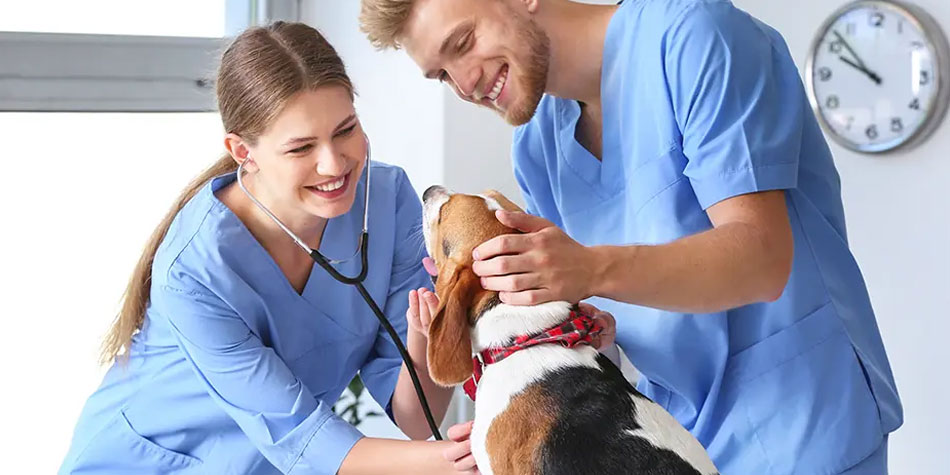
With this online Ed2Go course, offered in cooperation with SDSU Global Campus, you can turn your love of animals into a career entirely online in six months or less.
Become a Veterinary Assistant
Veterinary assistants are often the first person that pets and pet owners encounter when entering a veterinary office. They provide comfort and take charge of making sure office visits and procedures go smoothly for animals under veterinary care. With this online Veterinary Assistant training course, you can turn your love of animals into a career entirely online in six months or less.
Course Objective
- Summarize the roles, responsibilities, and applicable laws and ethics as they pertain to the veterinary healthcare team
- Discuss the fundamentals of animal anatomy and physiology, restraint techniques, and basic examination tasks relevant to veterinary assisting, using proper terminology
- Explain how to perform veterinary assistant pharmacy tasks within the law's scope and discuss vaccinations, infectious diseases, transmission, and prevention.
- Describe how to respond appropriately to veterinary medical emergencies, surgeries, and various laboratory procedures
- Understand how to perform the veterinary assistant’s responsibilities related to veterinary dentistry
Curriculum Outline
- The Veterinary Health-Care Team
- Veterinary Team Culture and Communication
- Introduction to Veterinary Medical Terminology
- Veterinary Anatomy, Physiology, and Terminology (Part I)
- Small-Animal Behavior and Restraint
- Veterinary Anatomy, Physiology, and Terminology (Part 2)
- Veterinary Receptionist Duties and Responsibilities
- Veterinary Inventory Management
- Pharmacy Procedures
- Hospital Safety and Infection Control
- Physical Exam and Patient History
- Small-Animal Vaccines and Infectious Diseases
- Small-Animal Nutrition
- Small-Animal Nursing Procedures
- The Human-Animal Bond and Euthanasia
- Laboratory Procedures for Veterinary Assistants
- Diagnostic Imaging for Veterinary Assistants
- Small-Animal Surgical Assisting
- Hospitalized Patient Care
- The Role of the Assistant During Emergencies
- Veterinary Dental Assisting
- Assisting with Exotic Species
- Assisting with Large-Animal Species
- Personal and Professional Development
- Beginning Your Career as a Vet Assistant
- Land the Job
Prerequisites and Requirements
There are no prerequisites to take this course.
Registration and Enrollment
This course is 100% online. Start anytime.
This program is eligible for tuition assistance through the Workforce Partnership.

Meet Your Instructor
Tracy Heyland
Tracy Heyland is a Registered Veterinary Technologist (RVT), earning the Academic and Practical Proficiency Award upon graduating. She brings 25+ years of experience in small animal medicine to her teaching, earned the Provincial Instructor Diploma, is certified as a Professional Co-Active Coach, and is Fear Free Certified. Tracy has worked in general practice, emergency medicine, veterinary sales, operations management, and teaching positions and runs her own coaching and training company for veterinary teams, leaders, and managers. Giving back to the veterinary profession is a passion of Tracy’s where she volunteers for a veterinary technologist program advisory committee, remotely located spay and neuter projects, and a veterinary technologist association continuing education committee.
California Job Outlook for Veterinary Assistants
Jobs for veterinary assistants are on the rise as more families add additional pets or bring pets into their homes for the first time. In fact, workforce analytics firm Burning Glass Technologies found that San Diego County is home to one of the fastest-growing job markets for veterinary assistants. It estimates that jobs for veterinary assistants will grow by 21% over the next decade. The U.S. Department of Labor estimates that an additional 2,700 veterinary assistants will be needed in California before 2029 - which means that 2,520 job openings will need to be filled each year in this field.
According to the Bureau of Labor Statistics, the average salary of a veterinary assistant is currently $29,930 per year. However, veterinary assistants in San Diego County earn $34,990 on average.
Veterinary Assistant FAQs
What Do Veterinary Assistant Responsibilities Involve?
The main job of a veterinary assistant is to support the veterinarian and other veterinary office staff, like veterinarian technicians, with basic tasks. Veterinary assistants will often greet patients and their owners when they enter a veterinary office. They feed, weigh, bathe and take the temperature of animals. They may also help give medication, clean cages and help restrain animals during treatment or other medical procedures as needed.
Do Veterinary Assistants Handle Administrative Duties?
Sometimes. Veterinary assistants may be asked to perform clerical work such as scheduling appointments and speaking with customers. They may also handle many logistical and operating duties, such as check-in, billing, and after-visit care. Duties will vary depending on the office you work in, but every task you undertake will help ensure the health and well-being of animals within the veterinary practice.
How Are A Veterinary Assistant And Veterinary Technician Different?
Veterinary assistants typically complete a certificate program that will teach them to perform basic duties within a veterinary practice. Veterinary technicians must complete formal education, such as a two-year associate degree accredited by the American Veterinary Medical Association (AVMA), and work as an animal nurse within veterinary practice.
Can I Go From A Veterinary Assistant To A Veterinary Technician Role?
Yes. Becoming a veterinary assistant is a great first step that will allow you to gain experience as you go back to school to complete your veterinary technician training and licensure. This path will help you better understand the industry, different specialties, and advanced duties required to work as a vet technician.
This program is offered in partnership with a third-party provider responsible for marketing, outreach, recruitment, curriculum design, and/or instructional services. The courses are not eligible for degree credit at SDSU and are not taught by University faculty nor associated with any campus academic department.
